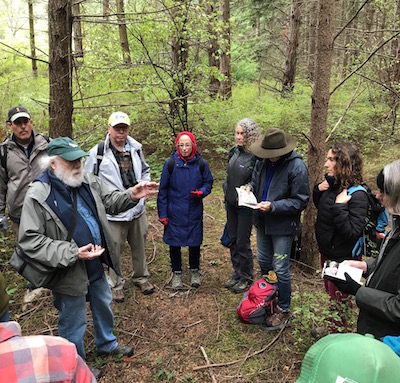Last month’s “Forest Fungi Foray” outing to Waldron Island attracted an enthusiastic group of Preservation Trust members. All was in place for a fine day of mushroom hunting.
The only thing missing was … well, mushrooms—or, at least, the hoped-for bounty of chanterelles, pig’s ears, lobsters, oysters, and shaggy manes that normally appear in the forest along Cowlitz Bay. Why were they no-shows? Our naturalist/guide, renowned mycologist Fred Rhoades, had a theory. …
 Our guide’s theory, in short, is that the hot, very dry summer of 2017 has stressed the forest trees whose roots host mycorrhizal fungi. These fungi form a mutually beneficial relationship with their host plants by making moisture and soil minerals more available to the trees’ roots. The trees, in turn, provide the fungi with carbohydrates (such as glucose and sucrose), which they photosynthesize in their leaves. The carbohydrates give the mycorrhizal fungi the energy they need to form fruiting bodies, better known as mushrooms. So, heat- and drought-stressed trees equal less carbohydrates in their root systems, which equals a lack of sufficient energy for the soil fungi to produce mushrooms. Many well-known edible mushrooms grow from mycorrhizal fungi—and there were few of these to be found during our October ramble. The usual mat of mycelium found just below the soil surface was conspicuously missing.
Our guide’s theory, in short, is that the hot, very dry summer of 2017 has stressed the forest trees whose roots host mycorrhizal fungi. These fungi form a mutually beneficial relationship with their host plants by making moisture and soil minerals more available to the trees’ roots. The trees, in turn, provide the fungi with carbohydrates (such as glucose and sucrose), which they photosynthesize in their leaves. The carbohydrates give the mycorrhizal fungi the energy they need to form fruiting bodies, better known as mushrooms. So, heat- and drought-stressed trees equal less carbohydrates in their root systems, which equals a lack of sufficient energy for the soil fungi to produce mushrooms. Many well-known edible mushrooms grow from mycorrhizal fungi—and there were few of these to be found during our October ramble. The usual mat of mycelium found just below the soil surface was conspicuously missing.
Other mushrooms, however, form from saprophytic fungi that derive their energy from dead and decomposing matter, rather than from healthy tree roots. Sharp-eyed members of our group spotted many of this type of forest fungi. Some tiny, delicate umbrella-tops emerged from decomposing fir cones; other, larger shelving specimens grew on rotting tree trunks and branches. Professor Rhoades stayed busy identifying and discussing these essential agents of forest nutrient recycling. So it was an educational outing, in spite of the scarcity of succulent edibles.
For the sake of our forests’ overall health, we hope the trees are less stressed next year, making for robust, well-fed mycorrhizae—which means more mushrooms to hunt next fall.
